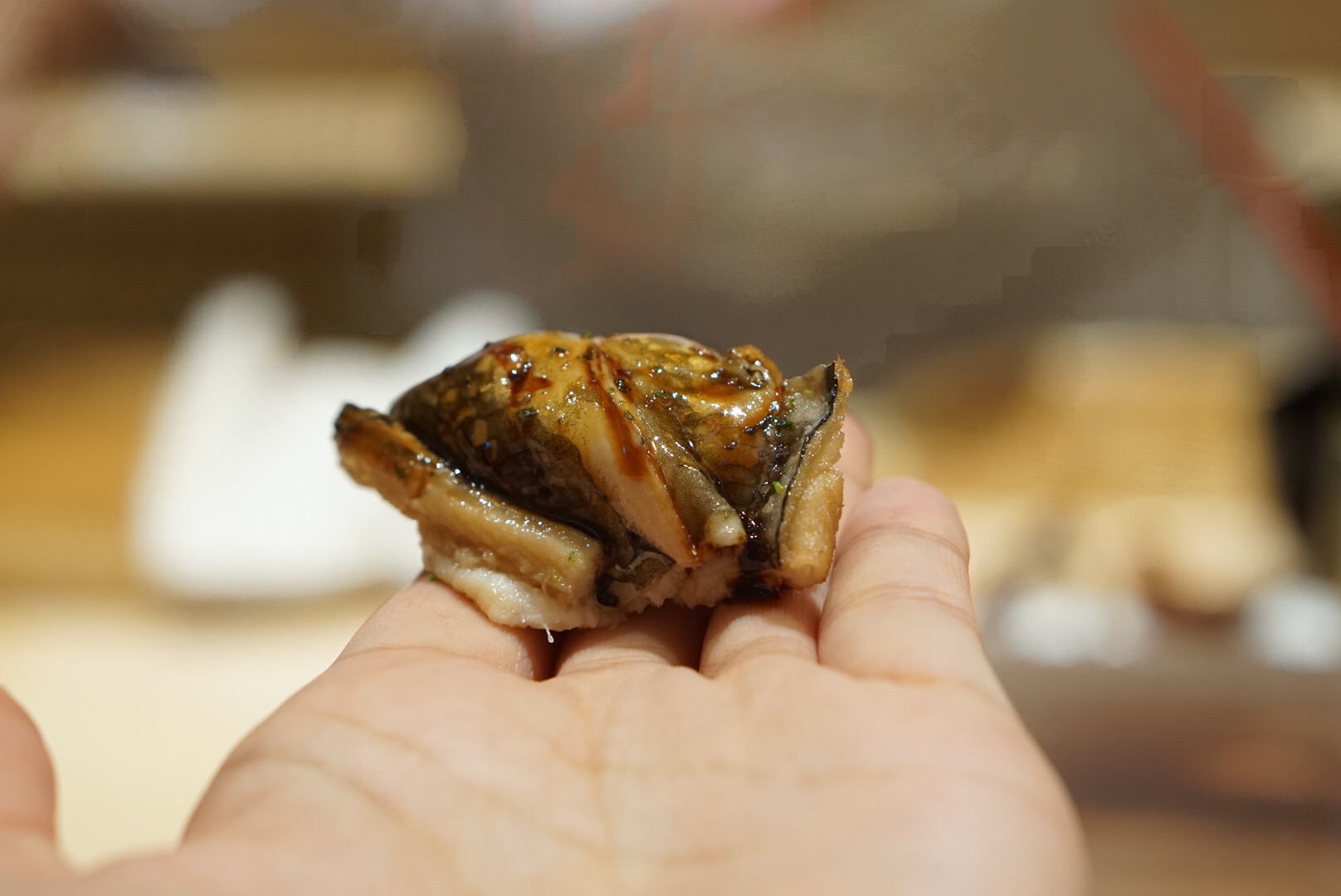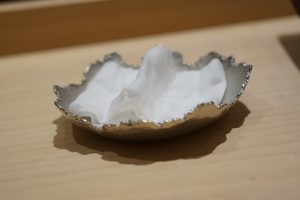
He welcomed me into his sushi bar at 7pm on 29th July. Singapore does not have four seasons like Japan does. It’s almost always hot, humid and summery. However, unlike Sydney, Singapore is able to get fresh seafood everyday from the famous Tsukiji fish markets in Tokyo. Consequently, Chef Koike’s customers can enjoy the same seasonal varieties that people do in Japan. This is especially important because Washoku is a seasonal cuisine with spring, summer, autumn and winter all being reflected in the dishes prepared by washoku chefs. The seasonal requirement for washoku dishes is problematic for washoku chefs living outside of Japan. In fact, all of the washoku chefs I have met in Australia say that this is the most difficult thing they have to deal with; getting the seasonal ingredients which they need for washoku.
To start, I ordered masu sake. Masu sake is sake served in a square wooden cup called a masu. I like the slight woody flavour that comes through with the sake when you drink it from a masu. In fact, if you like, you can put a touch of salt on the edge of the wooden cup to add to the flavour (just like some do with a glass of tequila!). From my experience, it’s not easy to find masu sake outside of Japan, especially in Sydney, though it is sometimes available for celebrations. I must say; I was very happy to start with my masu sake 🙂
We started with Isaki sashimi. Isaki is one of my favourite white fishes and it is known as Grunt fish in English. It is not normally found in Australia as it comes from the Western Atlantic Ocean, not the Pacific. The Isaki sashimi at Sushi 36 was perfectly seared aburi style. The size was perfectly portioned with just the right balance of fat and texture. It was truly delicious.
The shell fish used in this dish was still alive when it came time to prepare. This is truly amazing when you realise it had come all the way from Hokkaido! Shell fish are known as kai in Japan and the ones used on this night are known as nimai gai. Interestingly, I have not had nimai gai outside of Japan before, as they are very hard to export/import from Japan. The dish Chef Koji made expertly paired the nimai gai with eggplant from Senshu, Osaka and it’s called ishigaki gai. The texture was simply wonderful. I really love this particular eggplant; it is normally eaten as a sashimi vegetable or pickled.
When spring passes and summer begins, goma saba, a type of mackerel, is in season. Some people believe that goma saba has too strong a fishy smell than other types of mackerel. “This goma saba is not fishy smelling at all because of where it came from and when it was caught. How do I know these things? Because I have a strong connection with the fishermen who caught it,” says Chef Koji. Yes, I agree; the goma saba was not strong and fishy smelling at all. Rich in good fat and paired with the Japanese herb bouhu 防風, also imported from Japan, the dish was absolutely delicious and most definitely prepared at the perfect time to eat.
Amadai, a sweet snapper, comes in three types: red, yellow and white. Of the three, the white skin amadai is the most expensive. The dish was grilled in the kitchen by Elvis, who learned about Japanese cuisine at several izakaya restaurants before coming under the wing of the master, Chef Koji. Elvis is responsible for the grilled dishes and the amadai, as with all of his dishes, was perfectly cooked on the night.

Gari, the pickled ginger that’s often put on your plate or served as a side, is, in my opinion, one way to find out the quality of a restaurant. Some people love gari more than sushi, “no way”, I have to say, but I did love Chef Koji’s gari. Good quality gari tastes different from restaurant to restaurant. Find a good restaurant with good gari and enjoy it, I say!
Chef Koji believes that it’s important to make recipes simple. Being simple is not only important for flavour, but it also means that it’s easy for his staff to remember. This soup is made from only dashi, mirin and sake. I could feel Chef Koji’s passion in training his staff and in supporting them in one day opening their own restaurants. This is part of his dream, and passion, of expanding better quality Japanese food culture through trained chefs.
Eat it now! This is the thought that comes to mind when a sushi chef places a piece of delicious sushi in your hand. Sushi is already a delicious dish, but it can be even more. Delicately and deliciously seasoned and then served at just the right temperature for eating. So, my suggestion for you is is this: if a sushi chef places a piece of sushi in your hand, then you should definitely eat it straight away! If you remember this, dear sushi lovers, then you won’t be disappointed!
Ryan is standing on the right, next to Elvis. Ryan only started his washoku training this year after a career in classical French cuisine. I asked him why he chose to change his career from French to Japanese cuisine? After all, Japanese cuisine is one of the most difficult and detailed cuisines to be trained in (though I am sure that French cuisine is not easy either!). He said that he was once told that all the best chefs in the world were either Japanese or French chefs and he thought, what if I could merge the two? He said that he was very fortunate to meet Chef Koji and didn’t want to miss the opportunity to learn from him. All the best to him I say! I was very impressed to witness his passion to learn from Chef Koji. He stood near Chef Koji, watching him at all times, ever ready to offer a second pair of hands when needed. Watching Ryan it was very hard to believe that he has only been training this year! Chef Koji says that it is people like Ryan and Elvis that are the reason he wanted to open his restaurant in Singapore so that he could train non-Japanese chefs, out of Japan how to make proper sushi and expand quality sushi culture and Japanese cuisine. Ryan is proud to be taking up taking that opportunity.
Thank you for the wonderful opportunity to experience sushi in Singapore, Master Washoku Chef Koji. If you are looking for a sensational food experience in Singapore, I highly recommended that you go to Sushi 36.